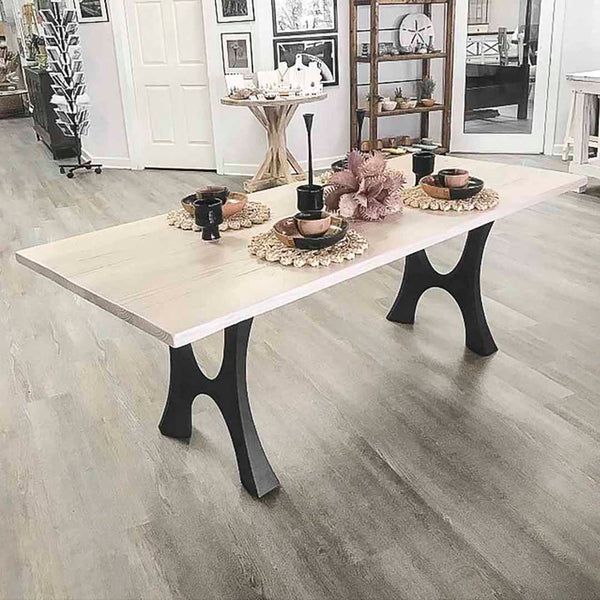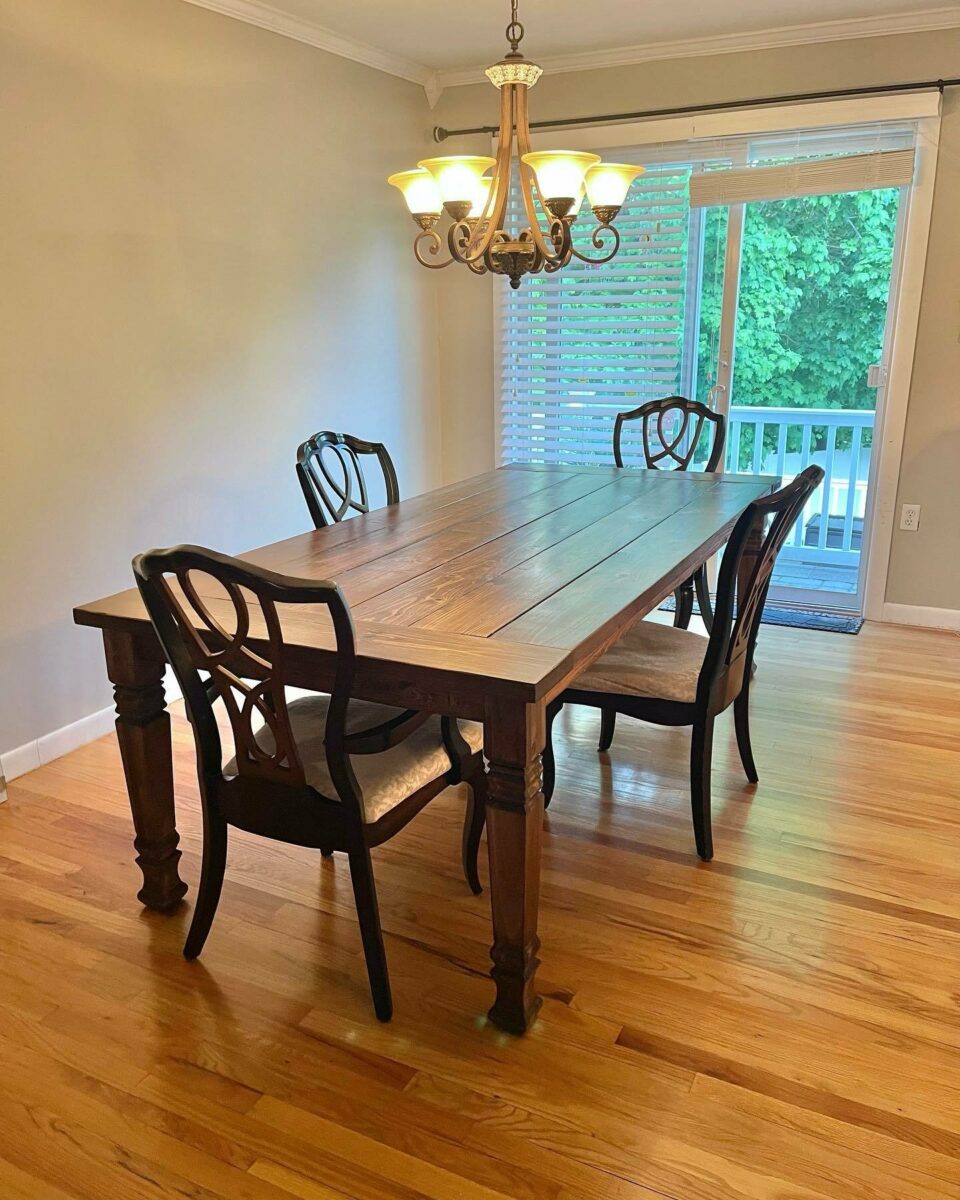Creative Ideas for Replacing or Refurbishing Your Dining Room Table Legs
Creative Ideas for Replacing or Refurbishing Your Dining Room Table Legs
Blog Article
From Typical to Modern: Find the Suitable Eating Space Table Legs for Your Style
While classic designs such as cabriole and transformed legs evoke a feeling of classic elegance, modern styles like hairpin and geometric alternatives offer an opportunity for striking aesthetic interest. As you take into consideration these components, the question continues to be: exactly how can you effortlessly incorporate these varied leg styles to develop a harmonious dining experience?
Recognizing Table Leg Styles
The variety of eating area table leg styles can substantially affect both the aesthetic appeals and capability of the area. Each leg design adds distinct aesthetic elements and practical attributes, dealing with diverse style preferences and use demands. Understanding these designs is vital for choosing the best eating table that aligns with your total interior decoration vision.
For instance, conical legs provide a tidy, timeless appearance that can boost a space's style, while pedestal bases supply stability and make the most of legroom, making them excellent for smaller sized rooms. Hairpin legs, a hallmark of mid-century modern-day layout, present a commercial panache, enabling a ventilated, open feeling. Trestle legs stimulate rustic charm, giving robust support and a sense of timelessness.
Wood legs can bring warmth and texture, whereas steel options usually convey a smooth, modern ambiance. Ultimately, recognizing table leg designs is crucial for developing a cohesive dining area that mirrors individual design while making sure usefulness and comfort.
Standard Table Leg Options
When choosing dining room table legs, typical options frequently personify classic beauty and craftsmanship. These styles mirror a rich heritage and a commitment to high quality, making them excellent for those who appreciate timeless aesthetics.
Among one of the most legendary standard leg styles is the cabriole leg, characterized by its stylish curved shape. This design usually includes ornamental carvings and is most typically discovered in Queen Anne and Chippendale furniture. An additional prominent alternative is the turned leg, which boasts a collection of smooth, rounded forms that supply a classic appearance while maintaining security.
Moreover, the straight leg, while easy, uses a basic and sturdy structure that can blend flawlessly with a range of tabletop styles. For those drawn to ornate detailing, claw-and-ball feet legs stimulate a sense of splendour and can act as a stunning focal factor in any kind of eating area.
Last but not least, stand bases, although not purely legs, provide an alternate traditional option that enables for adequate legroom and can be magnificently carved. Each of these conventional leg designs adds to the overall ambiance of a dining space, marrying feature with aesthetic allure.

Modern Table Leg Styles
Modern table leg layouts offer a diverse series of styles that stress cutting-edge products and clean lines. These styles typically prioritize performance while acting as striking centerpieces within a dining area. Minimal looks are common, with legs crafted from products such as metal, glass, and engineered timber, click reference which contribute to a modern and ventilated feel.
One popular style is the hairpin leg, characterized by its slender, conical structure that offers security without overwhelming the tabletop (dining room table legs). This design is commonly found in mid-century modern-day furniture and can easily match numerous table forms. Another pattern is making use of geometric shapes, where legs may handle angular or asymmetrical forms, including aesthetic rate of interest and a touch of creativity

Blending Styles for One-of-a-kind Rooms
Commonly, home owners look for to create distinct dining rooms that mirror their individual style by blending various style elements. This technique permits the incorporation of varied visual appeals, leading to a harmonious yet distinct atmosphere. For circumstances, matching a rustic wooden table with smooth, modern steel legs can create an appealing comparison that elevates the space's total appeal.
Furthermore, incorporating vintage table legs with modern table tops can evoke a sense of background while maintaining a contemporary sensibility. Such mixes not only display specific taste yet also urge creativity, permitting home owners to curate a room that really feels both personal and welcoming.
Shade plays an important duty in this blending process; selecting table legs that match or contrast with the existing color design can boost visual rate of interest. As an example, whitewashed legs can soften the daring of a dark table surface, creating a balanced visual.
Tips for Choosing the Right Legs
Picking the right table legs is important for accomplishing both performance and visual allure in your dining area. Begin by taking into consideration the general design of your space. Traditional setups gain from legs that feature elaborate carvings or turned styles, while modern areas may require sleek, minimalist designs.
Following, assess the height and security of the legs. dining room table legs. Common eating tables range between 28 to Read More Here 30 inches in More Info elevation, so guarantee the legs enhance this dimension for convenience. In addition, robust materials, such as wood or steel, can boost stability and longevity
Assess the leg shape also-- choices include right, tapered, or pedestal styles. Straight legs offer a timeless appearance, while conical legs can add a touch of sophistication. Pedestal bases give ample legroom and are ideal for smaller rooms.
Conclusion
In summary, picking the ideal eating space table legs calls for careful consideration of both conventional and modern-day designs. By harmonizing leg design, elevation, and product with the overall design, a cohesive and welcoming ambience can be attained.
The variety of eating room table leg designs can dramatically affect both the aesthetic appeals and functionality of the space. Ultimately, comprehending table leg designs is important for developing a cohesive dining area that reflects individual design while ensuring functionality and convenience.One of the most renowned standard leg designs is the cabriole leg, defined by its stylish bent form. Straight legs offer a classic look, while conical legs can include a touch of beauty.In summary, selecting the suitable eating area table legs requires mindful consideration of both modern-day and traditional styles.
Report this page